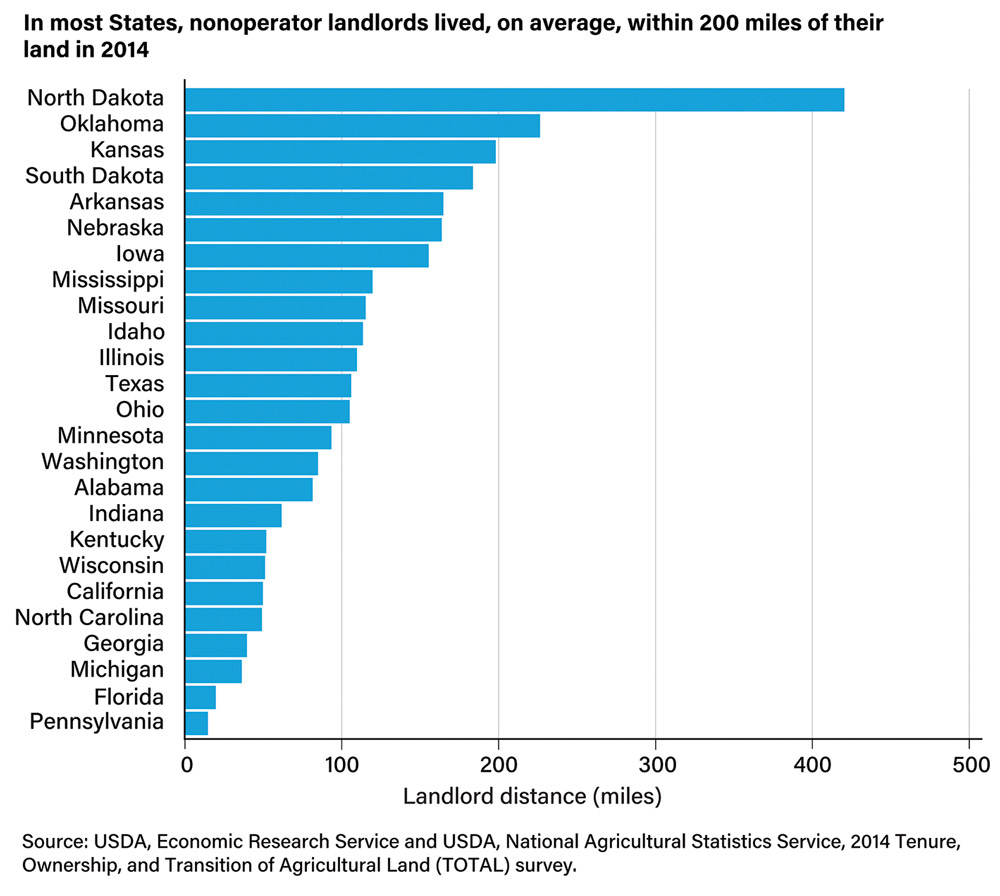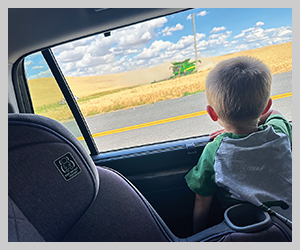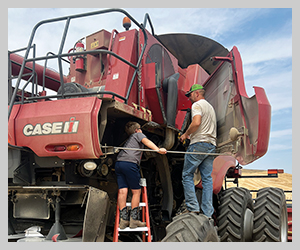
Given the low turnover in farmland ownership, access to farmland through rental markets is an important option for entry into farming or expanding existing farming operations. In 2014, 39 percent of farmland, or 355 million acres, in the 48 contiguous states was rented. Of this share, 80 percent was owned by landlords who did not operate farms. In Washington state, nearly 40 percent of farmland was rented. Illinois had the greatest share of acreage rented at just more than 60 percent, while Arizona was the lowest with approximately 7 percent.
Policymakers and academics are seeking to understand the role of absent landlords—landlords who live long distances from the land they rent out to farm operators—in farmland management and other aspects of local economies and resource management. In response to a congressional request in the 2018 Farm Bill, U.S. Department of Agriculture (USDA) Economic Research Service (ERS) researchers studied how longer distance-landlords affect the economic health of U.S. agricultural production. Looking into the association between landlord absenteeism and agricultural real estate markets, researchers found a greater prevalence of absent landlords in counties and states with lower rents and land values. At the same time, they found no association between absent landlords and recent changes in rents or land values.
Nonoperator landlords own the majority of rented farmland in the U.S., and most live close enough to their land to visit regularly. Those who live farther away may face different incentives than local landlords or farmers who operate their own property.
For this study, which was released in March 2021, ERS researchers examined a variety of measures of long-term economic and agricultural health for the 25 states with the largest cash receipts from agricultural operations, using data from the USDA, National Agricultural Statistics Service, Census of Agriculture and the 2014 Tenure, Ownership, and Transition of Agricultural Land (TOTAL) survey.

How far did nonoperating landlords live from their land on average? In the 25 states measured, the majority of nonoperating landlords in 2014 resided within 100 miles of the parcels they rented out. The Midwest differed from the rest of the U.S. in that the distances between landlords and tenants were, on average, significantly shorter than distances between landlords and tenants on the East and West coasts.
Landlords residing within 50 miles of their land owned the majority (67 percent) of agricultural acreage in 2014, and landlords residing within 200 miles owned 83 percent of the acreage. Nonoperator landlords who lived farther away from their rented land tended to have larger holdings than those who lived nearby. While absent landlords owned a sizable percentage of farmland acreage in some states, they did not own a majority of U.S. farmland in any state.
The average distance between nonoperator landlords and their rented land was less than 200 miles for the majority of states included in the analysis. North Dakota was an outlier, with an average distance of more than 400 miles, even though fewer than 30 percent of landlords live more than 200 miles away. In Washington, the average distance was 85 miles.
As participants in farm real estate markets, absent landlords can potentially influence land prices. Researchers found a negative trend between the three measures of landlord absenteeism—the percentage of those who live within 100 miles, the percentage within 200 miles and average distance—and the price of agricultural land in 2017. For each measure of landlord absenteeism, the line of best fit trended downward, indicating that higher rates of absenteeism are associated with lower average land values. This evidence, in isolation, does not allow the researchers to distinguish whether absent landlords hold higher shares of farmland in states with lower land values because it is more affordable to purchase, or because land values are lower in those states because of the effect of higher shares of absent landlords.
The number of absent landlords had little to no effect on how land values evolved over time. If absent landlords were directly influencing land values, the change in land values would be influenced by the level of landlord absenteeism. This finding suggests that the prevalence of absent landlords may not negatively influence the ability of farm operators to buy farmland by pricing them out of the market.
The association between the prevalence of absent landlords and measures of effort to improve soil health was mixed. There was no statistical association between the percentage of absent landlords and the percentage of acres utilizing conservation tillage or no-till farming practices in 2017. However, higher shares of absent landlords in a state were associated with a larger increase in acreage utilizing these practices as well as in the number of practices used from 2012 to 2017. Conversely, states with a higher percentage of absent landlords had a lower percentage of cropland with cover crop usage in 2017, but there was no statistical association between the percentage change in cover crop usage over the period studied.
This information was excerpted from a USDA ERS report by Siraj G. Bawa and Scott Callahan, called Absent Landlords in Agriculture – A Statistical Analysis ERR-281, U.S. Department of Agriculture, Economic Research Service, published on March 2021. The report can be downloaded here.












